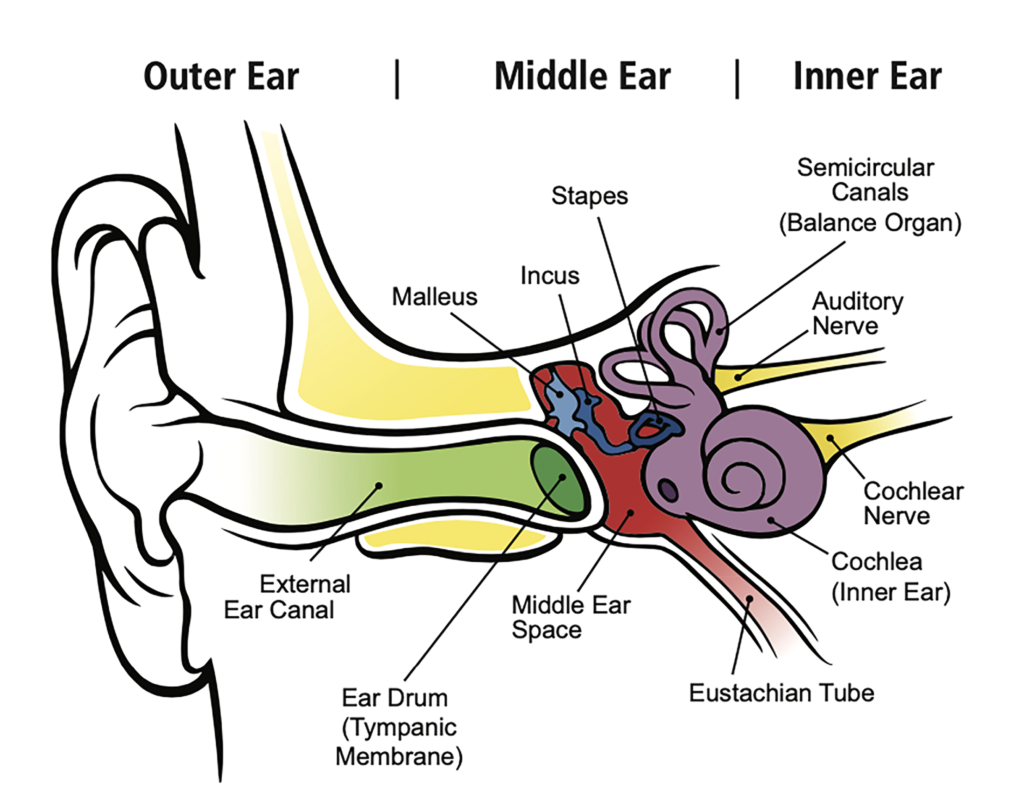The ear consists of three major compartments, the outer ear, the middle ear and the inner ear. Sound vibrations are collected by the outer ear and travel down the ear canal to the eardrum (also known as the tympanic membrane). When the sound waves reach the eardrum it causes it to vibrate in rhythm with the sound energy it is absorbing.
Attached to the opposite side of the eardrum is a chain of three tiny bones, the malleus, incus and stapes. You may recognize these by their more familiar names, the hammer, anvil and stirrup. These bones are the smallest bones in the body and are only about the size of a grain of rice. These bones are housed in the middle ear. Within the middle ear cavity is where the Eustachian tube is also located. The Eustachian tube connects the middle ear cavity to the back of the throat and it functions as a pressure equalizer. It also allows for drainage of accumulated secretions and debris from the middle ear space and it is usually closed except during chewing, swallowing and yawning.
At the end of the chain of bones, the stapes rests against a thin membrane called the oval window on a tiny organ in the inner ear called the cochlea. The cochlea is only about the size of pea and shaped like a snail shell. The cochlea is filled with fluid and approximately 40,000 microscopic nerve hair cells. Damage to these nerve hair cells is the leading cause of hearing loss. Embedded within the shell of the cochlea are tiny branch like structures called auditory fibers. The auditory fibers converge to form the auditory nerve outside the cochlea and the auditory nerve relays information from the cochlea to the brain.
Attached to the cochlea are three small loops, called the semi-circular canals. These canals are a major part of an elaborate system called the vestibular system, which is the system to help us maintain a sense of balance.
How The Ear Works
When the eardrum vibrates it sets the chain of bones in motion. The bones relay the vibration along the chain and also amplify the vibration as it travels along the chain. The chain ends with the stapes pressing against the membrane of the oval window on the cochlea, causing the fluid on the other side of the oval window to move in waves. This movement of the fluid stimulates the nerve hair cells to generate an electro-chemical impulse. These impulses are collected by the auditory fibers, carried to the auditory nerve and the auditory nerve relays the impulses to the brain. The brain interprets these impulses as sound and where the sound is originating from.
Some Common Causes of Hearing Loss
Problems that occur along the outer or middle ear are classified as a conductive hearing loss. Many of these problems can be corrected with medical intervention and/or surgery. Some possible causes of conductive hearing loss may be:
- Infection
- Fluid in middle ear
- Wax build up
- Tumors
- Congenital abnormalities
- Craniofacial abnormalities
- Otosclerosis (Abnormal bone growth in middle ear. If problem occurs on the stapes, sometimes it can be surgically replaced.)
When problems occur in the inner ear, the brain or along the nerve pathway the hearing loss is classified as sensorineural and this is the most common type of hearing loss. Sensorineural hearing loss is usually permanent or inoperable. Some causes of sensorineural hearing loss may include:
- Loud or excessive noise exposure…..Most common cause of hearing loss!
- Presbycusis….aging process
- Injury or head trauma
- Infections
- Meningitis
- Diabetes
- Stroke
- Hereditary
- Ototoxic medications….Medications that damage hearing
- Bacterial Meningitis
- Vascular or circulatory disorders
- Acoustic tumors
**The possible causes of hearing loss are numerous and these are only a few examples of possible causes**
When a person has a combination of both conductive and sensorineural hearing loss, the hearing loss is identified as a mixed hearing loss.

